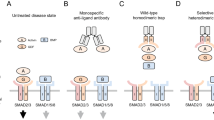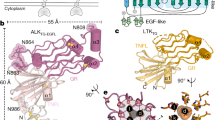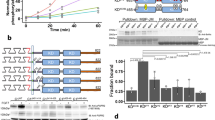Abstract
The transforming growth factor β (TGFβ) superfamily of cytokines elicit diverse biological responses by interacting with two distinct, but structurally related transmembrane receptor serine kinases (type I and type II). The binding of these dimeric ligands to the type II receptor is the first event in transmembrane signaling for this family. Here we report the 1.5 Å resolution crystal structure of the extracellular ligand-binding domain of the type II activin receptor (ActRII-ECD), which reveals a fold similar to that of a class of toxins known as three-finger toxins. This fold is primarily dictated by disulfide bonds formed by eight conserved cysteines, with a characteristic spacing, and thus is likely to be shared by most of the type I and II receptors for the TGFβ family. Sequence comparison with an evolutionarily distant activin binding-protein identifies several conserved residues, including two hydrophobic clusters that may form binding surfaces for activin and the type I receptor.
This is a preview of subscription content, access via your institution
Access options
Subscribe to this journal
Receive 12 print issues and online access
$189.00 per year
only $15.75 per issue
Buy this article
- Purchase on Springer Link
- Instant access to full article PDF
Prices may be subject to local taxes which are calculated during checkout




Similar content being viewed by others
Accession codes
References
Kessler, D.S. & Melton, D.A. Science 266, 596–604 (1994).
Vale, W., Hseuh, A., Rivier, C. & Yu, J. In Peptide growth factors and their receptors (eds Sporn, M. & Roberts, A.) 211– 248 (Springer-Verlag, Berlin; 1990).
Vale, W. et al. Nature 321, 776–779 (1986).
Mathews, L.S. & Vale, W.W. Cell 65, 973 –982 (1991).
Mathews, L.S. & Vale, W.W. Receptor 3, 173–181 (1993).
Wrana, J.L., Attisano, L., Wieser, R., Ventura, F. & Massague, J. Nature 370, 341– 347 (1994).
Attisano, L., Wrana, J.L., Montalvo, E. & Massague, J. Mol. Cell. Biol. 16, 1066–1073 (1996).
Lebrun, J.J. & Vale, W.W. Mol. Cell. Biol. 17, 1682–1691 (1997).
Donaldson, C.J., Vaughan, J.M., Corrigan, A.C., Fischer, W.H. & Vale, W.W. Endocrinology in the press.
Greenwald, J. et al. Biochemistry, 37, 16711– 16718 (1998).
Ruberte, E., Marty, T., Nellen, D., Affolter, M. & Basler, K. Cell 80, 889– 897 (1995).
Childs, S.R., Wrana, J.L., Arora, K., Attisano, L., O'Connor, M.B. & Massague, J. Proc. Natl. Acad. Sci. USA 90, 9475– 9479 (1993).
Rees, B. & Bilwes, A. Chem. Res. Toxicol. 6, 385–406 (1993).
McDonald, N.Q. & Hendrickson, W.A. Cell 73, 421–424 (1993).
Schlunegger, M.P. & Grütter, M.G. Nature 358, 430–434 (1992).
Daopin, S., Piez, K.A., Ogawa, Y. & Davies, D.R. Science 257, 369–373 (1992).
Young, L., Jernigan, R.L. & Covell, D.G. Prot. Sci. 3, 717– 729 (1994).
Clackson, T. & Wells, J.A. Science 267, 383–386 (1995).
Janin, J. & Chothia, C. J. Biol. Chem. 265, 16027–16030 (1990).
Yeates, T.O. Meth. Enz. 276, 344–358 (1997).
Otwinowski, Z. in Proceedings of the CCP4 study weekend (eds Sawyer, L., Isaacs, N. & Burley, S.) 56–62 (Daresbury Laboratory, Warrington, UK; 1993).
Collaborative Computational Project No. 4. Acta Crystallogr. D 50, 760–776 (1994).
Kleywegt, G. & Jones, T.A. In From first map to final model (eds Bailey, S., Hubbard, R. & Waller, D.) 59– 66 (Daresbury Laboratory, Warrington, UK; 1994).
Perrakis, A., Sixma, T.K., Wilson, K. & Lamzin, V.S. Acta Crystallogr. D 53, 448–455 (1997).
Jones, T.A., Zou, J.Y., Cowan, S.W. & Kjeldgaard, M. Acta Crystallogr. A 47, 100–119 (1991).
Bilwes, A., Rees, B., Moras, D., Menez, R. & Menez, A. J. Mol. Biol. 239, 122– 136 (1994).
Evans, S.V. J. Mol. Graphics 11, 134–138 (1993).
Barton, G.J. Prot. Engng. 6, 37–40 (1993).
Nicholls, A., Sharp, K.A. & Honig, B. Proteins Struct. Funct. Genet. 11, 281–296 (1991).
Acknowledgements
We thank G. Louie, R. Robinson and T. Hunter for helpful discussions and comments on the manuscript; H. Bellamy at SSRL and T. Earnest at ALS for help with data collection. SSRL and ALS are operated by the Department of Energy, Office of Basic Energy Sciences. The SSRL Biotechnology Program is supported by the National Institutes of Health, National Center for Research Resources, Biomedical Technology Program, and by the Department of Energy, Office of Biological and Environmental Research. J.G. is a Howard Hughes Medical Institute Predoctoral Fellow and Markey Fellow. S.C. is a recipient of a Klingenstein Fellowship Award in Neuroscience. This work was supported by a grant from the NIH.Correspondence should be addressed to S.C. choe@sbl.salk.edu
Author information
Authors and Affiliations
Corresponding author
Rights and permissions
About this article
Cite this article
Greenwald, J., Fischer, W., Vale, W. et al. Three-finger toxin fold for the extracellular ligand-binding domain of the type II activin receptor serine kinase.. Nat Struct Mol Biol 6, 18–22 (1999). https://doi.org/10.1038/4887
Received:
Accepted:
Issue Date:
DOI: https://doi.org/10.1038/4887
This article is cited by
-
Activin receptor type IIB in rohu (Labeo rohita): molecular characterization, tissue distribution and immunohistochemical localization during different stages of gonadal maturation
Fish Physiology and Biochemistry (2021)
-
The genetic basis of pulmonary arterial hypertension
Human Genetics (2014)
-
Natural velvet antler polypeptide conformation prediction and molecular docking study with TGF-β1 complex
Journal of Molecular Modeling (2013)
-
Toward a better understanding of the interaction between TGF-β family members and their ALK receptors
Journal of Molecular Modeling (2012)
-
Common structural traits for cystine knot domain of the TGFβ superfamily of proteins and three-fingered ectodomain of their cellular receptors
Cellular and Molecular Life Sciences (2011)



